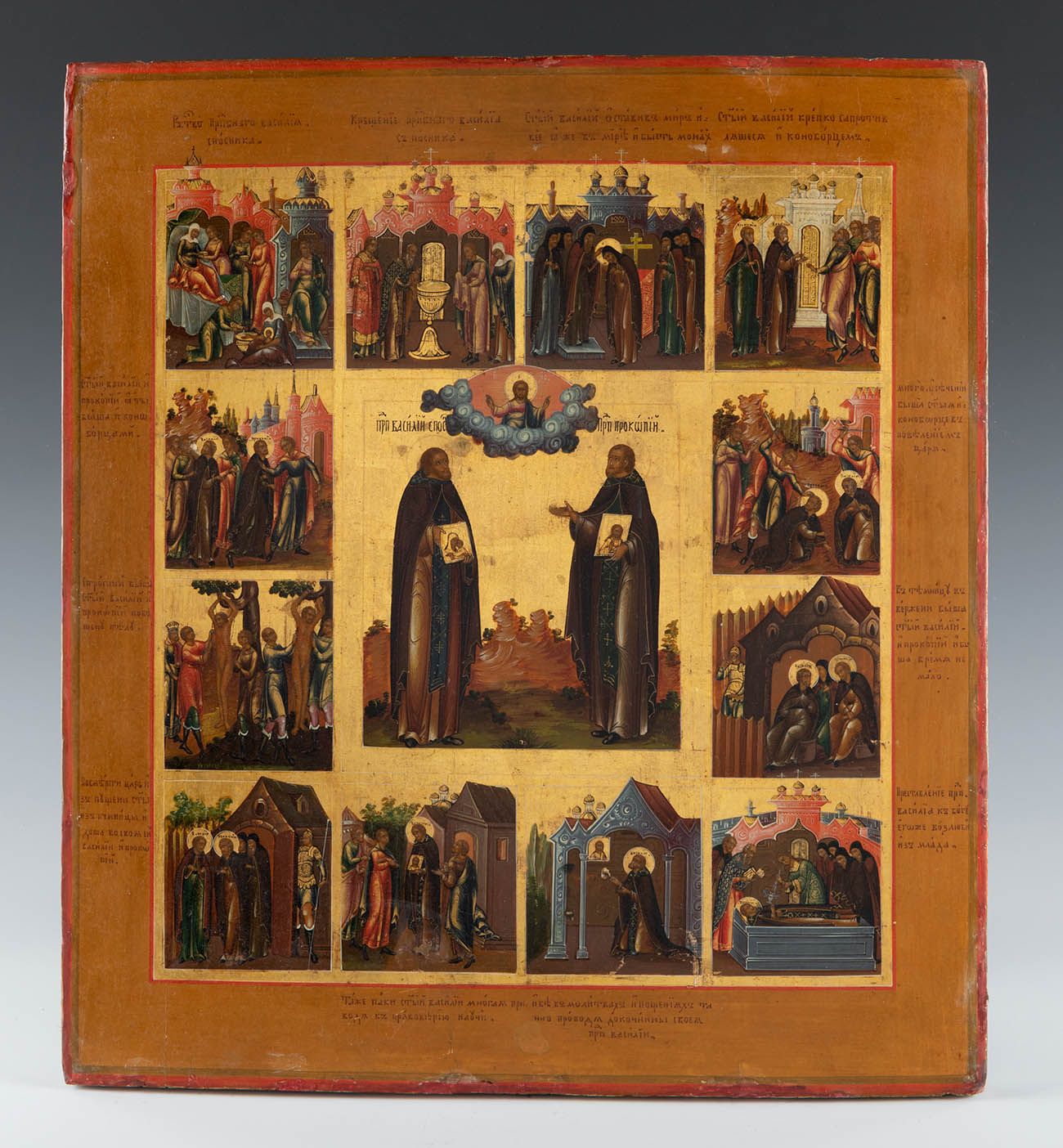Description
Russian school, workshops of the Old Believers, Moscow, 19th c. "Venerable Saints Basil and Prokopiy, his disciple with 12 hagiographic scenes". Tempera, gold leaf on panel. Measurements: 44,5 x 40 cm. Saint Basil (not to be confused with Basil the Great), who is to the left of the central register of the icon, lived during the reign of Leo the Iconoclast. Leaving the world with its temptations, he entered a monastery and led a virtuous monastic life. When there was persecution against the veneration of sacred icons, St. Basil bravely resisted the iconoclasts. For this he was imprisoned and subjected to many tortures, but in spite of this Basil rejected the heretical teaching of the iconoclasts and, together with St. Procopius, who stands to our right, defended the truth to the shedding of blood. Like the monk Prokopius, St. Basil, he was scourged all over his body; then he was imprisoned in the prison, where he languished for a long time, until the death of the pious King Leo. On the death of the torturer, the monk Basil was released together with St. Prokopius and other confessors and lived as before in works of fasting, converting many to the orthodox faith and leading them to a virtuous life. After several years of pious life, he was granted a blessed rest and with prayer, thanksgiving and unspeakable joy he went to the Lord, whom he had loved since his early childhood. The present icon has a series of twelve images, which relate the life of St. Basil from his birth to his death. Hagiographic icons are a typology of Orthodox iconography, and should be read as if they were a book, starting from the upper left corner to the lower right corner. All the images are accompanied by inscriptions on the outer border of the icon, explaining what is happening in each image. Together with the two-fingered blessing, which some saints have, and the name of Jesus Christ as "IC XC", it indicates that this is an icon made in the workshops of the Old Believers.
28
Russian school, workshops of the Old Believers, Moscow, 19th c. "Venerable Saints Basil and Prokopiy, his disciple with 12 hagiographic scenes". Tempera, gold leaf on panel. Measurements: 44,5 x 40 cm. Saint Basil (not to be confused with Basil the Great), who is to the left of the central register of the icon, lived during the reign of Leo the Iconoclast. Leaving the world with its temptations, he entered a monastery and led a virtuous monastic life. When there was persecution against the veneration of sacred icons, St. Basil bravely resisted the iconoclasts. For this he was imprisoned and subjected to many tortures, but in spite of this Basil rejected the heretical teaching of the iconoclasts and, together with St. Procopius, who stands to our right, defended the truth to the shedding of blood. Like the monk Prokopius, St. Basil, he was scourged all over his body; then he was imprisoned in the prison, where he languished for a long time, until the death of the pious King Leo. On the death of the torturer, the monk Basil was released together with St. Prokopius and other confessors and lived as before in works of fasting, converting many to the orthodox faith and leading them to a virtuous life. After several years of pious life, he was granted a blessed rest and with prayer, thanksgiving and unspeakable joy he went to the Lord, whom he had loved since his early childhood. The present icon has a series of twelve images, which relate the life of St. Basil from his birth to his death. Hagiographic icons are a typology of Orthodox iconography, and should be read as if they were a book, starting from the upper left corner to the lower right corner. All the images are accompanied by inscriptions on the outer border of the icon, explaining what is happening in each image. Together with the two-fingered blessing, which some saints have, and the name of Jesus Christ as "IC XC", it indicates that this is an icon made in the workshops of the Old Believers.
You may also like
